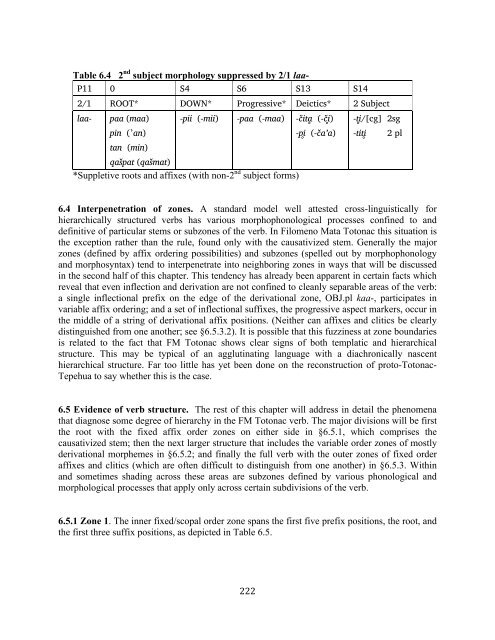The phonology and morphology of Filomeno Mata Totonac
The phonology and morphology of Filomeno Mata Totonac
The phonology and morphology of Filomeno Mata Totonac
Create successful ePaper yourself
Turn your PDF publications into a flip-book with our unique Google optimized e-Paper software.
Table 6.4 2 nd subject <strong>morphology</strong> suppressed by 2/1 laa-<br />
P11 0 S4 S6 S13 S14<br />
2/1 ROOT* DOWN* Progressive* Deictics* 2 Subject<br />
laa- paa (maa)<br />
pin (’an)<br />
tan (min)<br />
-pii (-mii) -paa (-maa) -c%ita& (-c%i&)<br />
qas%pat (qas%mat)<br />
*Suppletive roots <strong>and</strong> affixes (with non-2 nd subject forms)<br />
! ###!<br />
-pi& (-c%a’a)<br />
-ti&/[cg] 2sg<br />
-titi& 2 pl<br />
6.4 Interpenetration <strong>of</strong> zones. A st<strong>and</strong>ard model well attested cross-linguistically for<br />
hierarchically structured verbs has various morphophonological processes confined to <strong>and</strong><br />
definitive <strong>of</strong> particular stems or subzones <strong>of</strong> the verb. In <strong>Filomeno</strong> <strong>Mata</strong> <strong>Totonac</strong> this situation is<br />
the exception rather than the rule, found only with the causativized stem. Generally the major<br />
zones (defined by affix ordering possibilities) <strong>and</strong> subzones (spelled out by morpho<strong>phonology</strong><br />
<strong>and</strong> morphosyntax) tend to interpenetrate into neighboring zones in ways that will be discussed<br />
in the second half <strong>of</strong> this chapter. This tendency has already been apparent in certain facts which<br />
reveal that even inflection <strong>and</strong> derivation are not confined to cleanly separable areas <strong>of</strong> the verb:<br />
a single inflectional prefix on the edge <strong>of</strong> the derivational zone, OBJ.pl kaa-, participates in<br />
variable affix ordering; <strong>and</strong> a set <strong>of</strong> inflectional suffixes, the progressive aspect markers, occur in<br />
the middle <strong>of</strong> a string <strong>of</strong> derivational affix positions. (Neither can affixes <strong>and</strong> clitics be clearly<br />
distinguished from one another; see §6.5.3.2). It is possible that this fuzziness at zone boundaries<br />
is related to the fact that FM <strong>Totonac</strong> shows clear signs <strong>of</strong> both templatic <strong>and</strong> hierarchical<br />
structure. This may be typical <strong>of</strong> an agglutinating language with a diachronically nascent<br />
hierarchical structure. Far too little has yet been done on the reconstruction <strong>of</strong> proto-<strong>Totonac</strong>-<br />
Tepehua to say whether this is the case.<br />
6.5 Evidence <strong>of</strong> verb structure. <strong>The</strong> rest <strong>of</strong> this chapter will address in detail the phenomena<br />
that diagnose some degree <strong>of</strong> hierarchy in the FM <strong>Totonac</strong> verb. <strong>The</strong> major divisions will be first<br />
the root with the fixed affix order zones on either side in §6.5.1, which comprises the<br />
causativized stem; then the next larger structure that includes the variable order zones <strong>of</strong> mostly<br />
derivational morphemes in §6.5.2; <strong>and</strong> finally the full verb with the outer zones <strong>of</strong> fixed order<br />
affixes <strong>and</strong> clitics (which are <strong>of</strong>ten difficult to distinguish from one another) in §6.5.3. Within<br />
<strong>and</strong> sometimes shading across these areas are subzones defined by various phonological <strong>and</strong><br />
morphological processes that apply only across certain subdivisions <strong>of</strong> the verb.<br />
6.5.1 Zone 1. <strong>The</strong> inner fixed/scopal order zone spans the first five prefix positions, the root, <strong>and</strong><br />
the first three suffix positions, as depicted in Table 6.5.

















